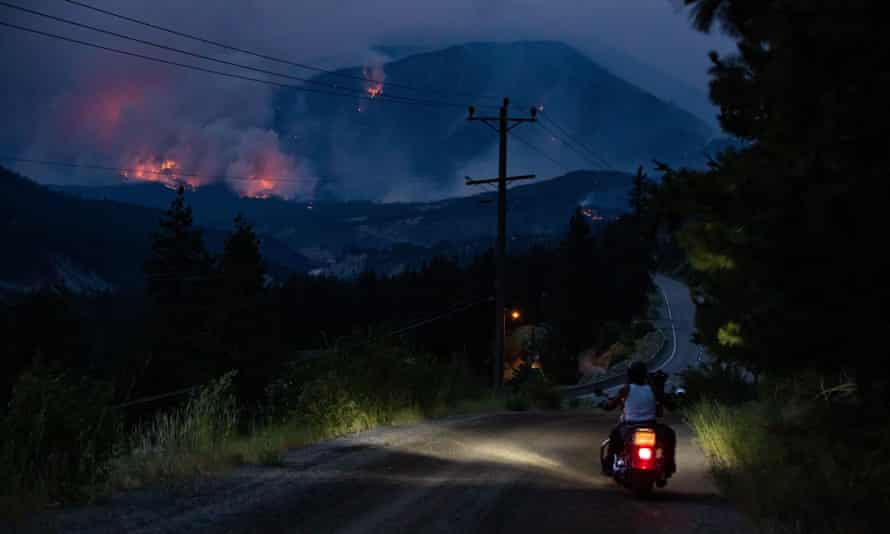Canadian inferno: northern heat exceeds worst-case climate models
Scientists fear heat domes in North America and Siberia indicate a new dimension to the global crisis

Last modified on Fri 2 Jul 2021 18.19 EDT
If you were drawing up a list of possible locations for hell on Earth before this week, the small mountain village of Lytton in Canada would probably not have entered your mind.
Few people outside British Columbia had heard of this community of 250 people. Those who had were more likely to think of it as bucolic. Nestled by a confluence of rivers in the forested foothills of the Lillooet and Botanie mountain ranges, the municipal website boasts: “Lytton is the ideal location for nature lovers to connect with incredible natural beauty and fresh air freedom.”
Over the past seven days, however, the village has made headlines around the world for a freakishly prolonged and intense temperature spike that turned the idyll into an inferno.
The US president, Joe Biden, and Canadian prime minister, Justin Trudeau, have warned worried populations to brace for more. Shocked climate scientists are wondering how even worst-case scenarios failed to predict such furnace-like conditions so far north.
Johan Rockstrom, the director of the Potsdam Institute for Climate Impact Research, said the recent extreme weather anomalies were not represented in global computer models that are used to project how the world might change with more emissions. The fear is that weather systems might be more frequently blocked as a result of human emissions. “It is a risk – of a serious regional weather impact triggered by global warming – that we have underestimated so far,” he said.
In Lytton, it felt as if the weather itself had stagnated. Trapped in a vast heat dome that enveloped western Canada and the north-western US, temperatures had nowhere to go but up.
In Lytton, the Canadian national heat record was broken on Monday, smashed on Tuesday and then obliterated on Wednesday when the local monitoring station registered 49.6C (121F).
After the insufferable heat came choking fire. First the forest burned, then parts of the town. On Wednesday evening, the mayor, Jan Polderman, issued the evacuation order. “It’s dire. The whole town is on fire,” he said on TV. “It took, like, a whole 15 minutes from the first sign of smoke to, all of a sudden, there being fire everywhere.” By Thursday, satellite images showed an eruption of blazes around the village and a widening smoke cloud across the region.
Police stations and hospitals reported a surge in heat-related deaths – 486 in British Columbia, and dozens more south of the border. Roads buckled as asphalt expanded. At least one city suffered power cuts.
The psychological, political and economic impacts are harder to quantify, but for many, along with the horror came a sense of bewilderment that these northern territories were hotter than the Middle East. David Phillips, the Canadian government’s senior climatologist, summed it up in an interview with CTV. “I mean, it’s just not something that seems Canadian.”

More people in more countries are feeling that their weather belongs to another part of the world. Across the border, in Washington state, the maximum heat measured at Olympia and Quillayute was 6C higher than the previous all-time record, according to the Weather Prediction Centre. In Oregon, the town of Salem hit 47C, smashing the previous record by 9C. Several areas of California and Idaho also saw new highs.
The previous week, northern Europe and Russia also sweltered in an unprecedented heat bubble. June records were broken in Moscow (34.8C), Helsinki (31.7C), Belarus (35.7C) and Estonia (34.6C).
Further east, Siberia experienced an early heatwave that helped to reduce the amount of sea ice in the Laptev Sea to a record low for the time of year. The town of Oymyakon, Russia, widely considered to be the coldest inhabited place on Earth, was hotter (31.6C) than it has ever been in June. This followed a staggeringly protracted hot spell in Siberia last year that lasted several months.
Carlo Buontempo, director of the Copernicus Climate Change Service, said there was a clear human fingerprint on this “very freakish” event. Without emissions from cars, farms and industry, he said, the record temperatures in the western north Americas would be expected only once in tens of thousands of years, but the probability rises along with the levels of the greenhouse gas. “In the present-day climate, getting an extremely hot June is common and is likely to occur twice in three decades. However, an analysis from many computer models suggests that by the end of the century these extreme temperatures are more likely than not. Human influence is estimated to have increased the likelihood of a new record several thousand times.”
Rising temperatures can be seen across the world. Even in the Middle East, temperatures of 50C plus were once outliers, but parts of Pakistan, India, Australia, the US and Canada are now regularly approaching or passing that mark.
But the intensity of the heat in the north-west Americas this year and Siberia last year has taken many scientists by surprise and suggested extra factors may be involved in northern latitudes.
One theory is that the recent temperature spike might have been caused not just by global heating, but by slowing weather systems that get stuck in one place for an extended period, which gives them time to intensify and cause more damage. This was an important factor in the devastation in Texas caused by Hurricane Harvey in 2018, which sat above Houston for several days rather than blowing inland and weakening. Blocked high-pressure fronts were also blamed for the blistering heatwave in Europe in 2019.
Experts at the Potsdam Institute and elsewhere believe the rapid heating in the Arctic and decline of sea ice is making the jet stream wiggle in large, meandering patterns, so-called Rossby resonance waves, trapping high- and low-pressure weather systems in one location for a longer time.
This theory remains contested, but Michael Mann, director of the Earth System Science Center at Pennsylvania State University, said this week’s unexpectedly fierce heat at Lytton and elsewhere should prompt climatologists to consider additional impacts of human activity.
“We should take this event very seriously,” he wrote in an email. “You warm up the planet, you’re going to see an increased incidence of heat extremes. Climate models capture this effect very well and predict large increases in heat extremes. But there is something else going on with this heatwave, and indeed, with many of the very persistent weather extremes we’ve seen in recent years in the US, Europe, Asia and elsewhere, where the models aren’t quite capturing the impact of climate change.”
Regardless of which interactions are to blame, scientists are agreed that the simplest way to reduce the risk of further temperature jolts is to cut fossil fuel emissions and halt deforestation.
“It appears that this heatwave is still a rare phenomenon in the current climate, but whether it stays that way depends on our decisions,” Friederike Otto, associate director of the Environmental Change Institute at the University of Oxford, said. “If the world does not rapidly eliminate fossil fuel use and other sources of greenhouse gas emissions like deforestation, global temperatures will continue to rise and deadly heatwaves such as these will become even more common.”